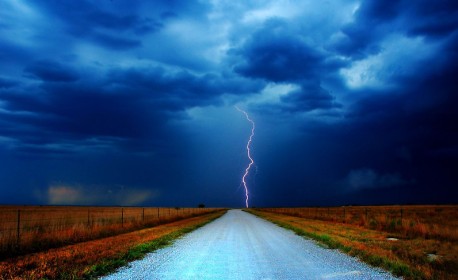THE SUMMER THUNDERSTORM season has made me do some reading and reasoning on the topic of protecting your amateur radio equipment from lightning.
In recent years, static dissipators on top of towers have become popular at broadcast stations — multiple sharply-pointed metal rods that supposedly draw off the static charge slowly and thus prevent a strike.
Bill, KD0HG, writes that in mountaintop broadcast installations where the rocky soil has extremely poor conductivity, they abandon the concept of “grounding” and simply concentrate on bonding the tower, the building, and the racks together with very low inductance copper strap — and surround the building with a perimeter strap too. The idea here is simply to keep everything at the same potential. Even if that potential elevates to 100,000 volts from “ground,” it won’t matter if there is no voltage difference between the bonded units. That’s a smart way to look at it.
But I have some new thoughts on the matter. Is it possible for one’s ham shack to simply “retire from the field” of ground-to-sky or sky-to-ground electron pulses?
That is, when not in use, completely disconnect from aerials — and from ground.
Sky-to-ground and ground-to-sky are just reciprocals of each other, depending on whether it’s a dearth or surfeit of electrons we’re talking about. So I think it’s useful from a safety theory standpoint to visualize all lightning strikes as energy emerging from the ground and attempting to reach a charged zone in the air.
So why not just make it (nearly) impossible for energy in the ground to pass through our ham gear? In addition to disconnecting the shack from our antennas, also disconnect it from ground — disconnect it from anything having a DC or low-impedance connection to ground, like ground radials or AC lines — and disconnect it from anything having a high capacitance to ground, like counterpoise systems.
Meanwhile, trees or a nearby grounded tower could provide a current path when a path was demanded by Mother Nature. But your gear wouldn’t be involved.
I know such near-total isolation from ground might be difficult, especially the AC mains part. It might take some creative thinking. (For example, during storm season in my old shack in Alexandria, Virginia, I used to remove the antenna’s parallel feeders from my gear and toss them out the window, many feet from the house. Could something analogous be done with the AC power feed to the shack?)
It should be possible to make our gear no more likely to get damaged by lightning than is an unplugged clock radio sitting inside a steel box which is itself sitting on a wooden pallet.
Of course, induced currents from nearby strikes would still occur. But with nothing connected to our gear except a few short wires disconnected from the outside world in every way, even that risk would be minimized.
Just food for thought.
